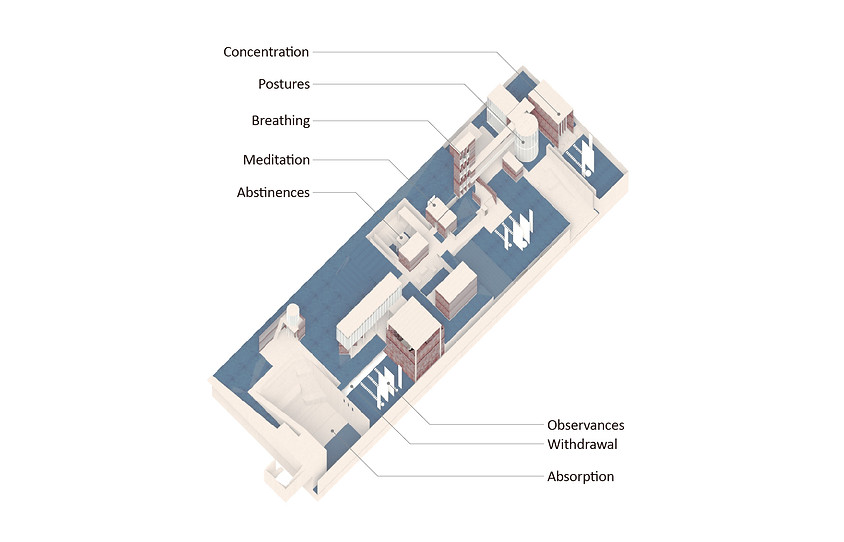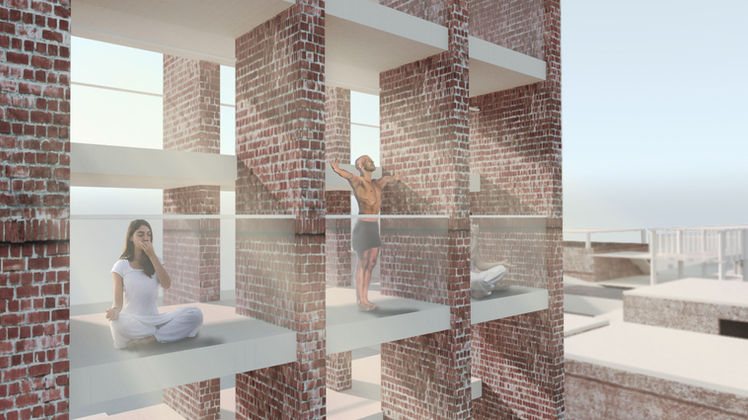

Museum of Knowledge - the Body, the Spirit, and the Universe
Competition of "Chandigarh Unbuilt"
2015
Work Type: Team of Two
Location: Chandigarh, India
Mentor: Kwang-Tyng Wu
Role in Team: Yoga Research, Diagrams Drawing, 3D Modelling, Collage Perspectives, Axometrics, Technical Drawings
Yoga is part of the fundamental knowledge and the spiritual principles that form Indian culture. Specifically, in addition to physical activity such as exercise, yoga includes various mental disciplines and practices that eventually lead yoga practitioners to achieve the fusion of soul and cosmic spirit.
Concerning the postures of yoga, we can decompose each pose into a few sequences of body movements. Interestingly, when we track the trail of the head, the hand, or the foot, we can discern the moving pattern in two ways. The first one is to break up the pose into horizontal movements, showing how consecutive poses are connected to one through time. The other way is to overlap isolated body movements, demonstrating how each part of the human body interacts with space when performing a specific set of poses.
The targeted site located in Chandigarh was an experimental site for Le Corbusier, one of the most influential architects and urban planners of the 20th century. However, most proposed projects for the site are still unbuilt or unable to continue. Thus, the topic of this competition -the Museum of Knowledge-has so far still been in a preliminary concept and the architect envisioned it to be a reinterpretation of ethics, sociology, economics, and technology in the present and future.
Our goal is to reproduce the spirit of yoga through poetic spaces so that knowledge of India can be displayed, and people can sense it within and beyond a museum in Chandigarh.
Ashtanga - The Eight Limbs of Yoga

Horizontal Posture Sequences

Overlapped Posture Sequences

Water and Yoga
Water is an essential element of Indian life. For thousands of years, Indians built stepped ponds for storing water resources and as sites for socializing with one other. On the other hand, the amorphous feature of water represents the fusion of raw materials, which is like a naturally-formed textbook guiding people to perceive the connection of their inner mind and the external world. Thus, we propose to submerge 70% of the site in a water landscape.
There is another goal is to create diverse types of space corresponding with each principle in the Eight Limbs of Yoga so that the spirit can be demonstrated through poetic space. For this reason, the water plays a significant role in reflecting oneself and creating either a tranquil or inspiring environment for practicing yoga.

Spaces of the Eight Limbs
The Connection between the Human Body and Spiritual Space
We attempted to characterize and present each area of the Museum of Knowledge according to the spiritual principles of yoga. Imagine a scene of tranquil water ponds and an oriental sunrise with sunlight spreading, sounds of water dripping, and gentle breezes. The combination of those elements evokes a primitive human feeling that people can clearly recognize and introspect on with their own inward vision and then convey to surroundings, and vice versa, through movements and emotion.
Nevertheless, our design intent is not to fit each space to a specific rule of yoga respectively. We have made an effort to reproduce the spirit of yoga through poetic spaces so that knowledge of India can be displayed, and people can sense it within and beyond a museum in Chandigarh.
Project gallery





















